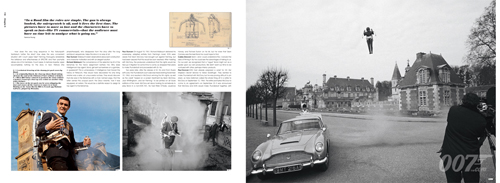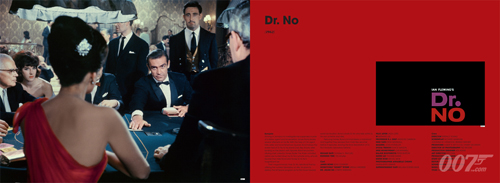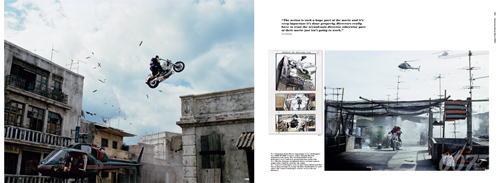 |
| |
007.com has released the first preview of the forthcoming "James Bond Archives", coming this year from Taschen...
|
|
James Bond Archives - Book Preview
27th July 2012
"Bond, James Bond." Since Sean Connery uttered those immortal words in 1962, the most dashing secret agent in the history of cinema has been charming and thrilling audiences worldwide. This impeccably British character created by author Ian Fleming has starred in 23 EON-produced films, played by 6 different actors over five decades.
To celebrate 50 years of this innovative franchise, EON Productions opened their archives of photos, designs, storyboards, and production materials to editor Paul Duncan, who spent two years researching over one million images and 100 filing cabinets of documentation. The result is the most complete account of the making of the series, covering every James Bond film ever made, beginning with Dr. No (1962) and ending with the upcoming SkyFall (2012), including the spoof Casino Royale (1967) and Never Say Never Again (1983).
The stunning imagery is accompanied by an oral history recounted by over 150 cast and crew members, relating the true inside story of how the Bond films were made. Containing previously unpublished photography and artwork, as well as production memos from filming, this book is a comprehensive tribute to the legend of James Bond.
Author Interview
PAUL, HOW DID THE BOOK COME ABOUT?
Ten years ago in my job interview with publisher Benedikt Taschen, he said, "I've always wanted to do a big James Bond book," so it was an idea that had always been there. Then over two years ago he brought it up again, and a couple of months later I got a call from EON asking if we'd like to do the book for the 50th anniversary of Bond. I said, "Sure, when did Benedikt contact you?" But he hadn't. TASCHEN and EON had the same idea at the same time. It was one of those great moments of synchronicity.
IT IS TRUE THIS TOOK TWO YEARS TO COMPILE?
It was about two and a half years. At TASCHEN we have had four and six year projects, because we spend a lot of time on research, getting things right and showing things that people haven't seen before.

(click to enlarge)
|
WHAT WILL THE FANS BE SEEING IN THIS BOOK?
The approach has been to include the iconic images that people love, but augment them with material that nobody has published before. Those two and a half years were spent in the archive looking for things that haven't been printed before. We have storyboards, production designs, some technical drawings, and the production documents. Nobody has been through those systematically, looking at all the cables, telexes, faxes and internal documentation that tells us what happened and when, what were the problems and how were they solved.
DID THOSE DOCUMENTS THROW UP ANY SURPRISES?
While filming in Jamaica on DR. NO, producer Cubby Broccoli sent a cable to United Artists in New York asking for somebody to go down to Sak's Fifth Avenue and pick up six white bikinis. We have that cable. This is a few days before they shoot the scene on the beach where Ursula Andress comes out of the water. They sent the bikinis to Tessa Welborn, who had her own boutique on the island, and she adapted the bikinis to be the one that you see on screen. It's only with the aid of hindsight that we can go through these documents and pick out the things that are important.
THERE ARE 100 FILING CABINETS AND A MILLION IMAGES IN THE BOND ARCHIVE. HOW HARD WAS THAT TO EDIT DOWN?
It was incredibly difficult. But that's why I'm called the editor. It's my job to "kill my darlings" as William Faulkner wrote. The volume of material is incredible, but my approach has been that it's about the people who make the films telling their story. It's an oral history. So it's Cubby Broccoli, Ken Adam, Terence Young, and Peter Lamont all telling their personal stories of what happened.

(click to enlarge)
|
WHAT WAS YOUR GREATEST DISCOVERY?
I think I found the bikini cable on the first day I was in the archive and I thought, "Oh my god, I can't believe I've found this." It showed me that there was material there to be found. It kept me going. Another great thing I discovered was with Roger Moore on THE SPY WHO LOVED ME. At the end of the film Karl Stromberg fires his gun and a chair blows up. Roger Moore was supposed to stand behind the chair but he decided to sit down on it. He got off it pretty quickly as it exploded, but he got caught on the behind. I found the medical document saying that he had to have the wound dressed and some cream applied to his backside.
DID YOU HAVE A FAVOURITE PIECE OF ARTWORK?
I loved Ken Adam's work on THE SPY WHO LOVED ME and MOONRAKER. The quality of the drawings is phenomenal. What you see in the sketches is not just the design, but also the thinking behind it. The set that you see on film is never the idea he starts with. There is a process he has to go through and for every sketch you see in the book, there are a dozen more that led up to it.
WAS THERE MORE MATERIAL ON SOME FILMS, LESS ON OTHERS?
There was more on some films and incredibly more on others. There was never a dearth – more of a deluge.
YOU'VE INCLUDED THE TWO UNOFFICIAL BOND FILMS IN THERE AS WELL RIGHT?
That's right, the 1967 CASINO ROYALE and 1983 NEVER SAY NEVER AGAIN were not made by EON who produce the official Bond movies. We've taken a slightly different approach to those in that we're using already existing text material: we're reprinting an interview with Sean Connery, and for the 1967 CASINO ROYALE we're reprinting an article written at the time about the making of it.

(click to enlarge)
|
WERE YOU A MAJOR BOND FAN BEFORE YOU STARTED THIS?
I grew up watching Bond movies. I remember as a kid, during my summer holidays in Ilfracombe, going to see DIAMONDS ARE FOREVER, and also the excitement when the films were first shown on television. I'm naturally interested in film and filmmaking and Bond was part of my growing up, but I never came with any pre-conceived ideas. I just came with an open mind.
YOU'VE EDITED MORE THAN 50 BOOKS, HOW DID THIS DIFFER FROM THE OTHERS YOU HAVE COMPILED AND WRITTEN?
The sheer volume of material was both daunting and exciting, but after reading it, I found that it contained a multitude of human stories, and I hope that readers will respond to those. The Bond movies are made by fantastically creative casts and crews, and many of these people, sometimes whole families, have worked on the films throughout their career. It's ironic, I think, that a series about a lone wolf investigator is only successful because of good teamwork.
The James Bond Archives, edited by Paul Duncan, is available to pre-order now in hardcover (with an original film strip from a new print of DR. NO included with the first printing of the book), 16.2 x 11.8 in., 600 pages £135/$200/€150.